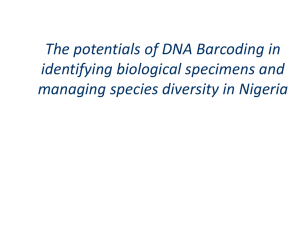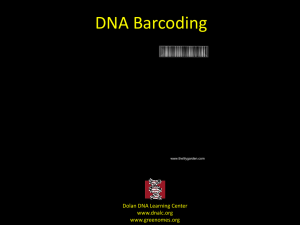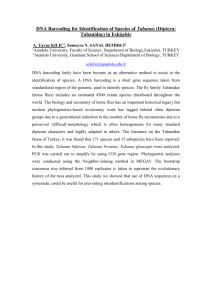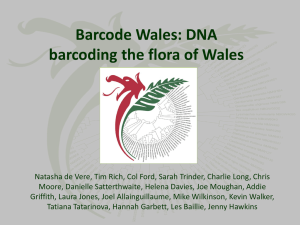DNA Barcoding
advertisement
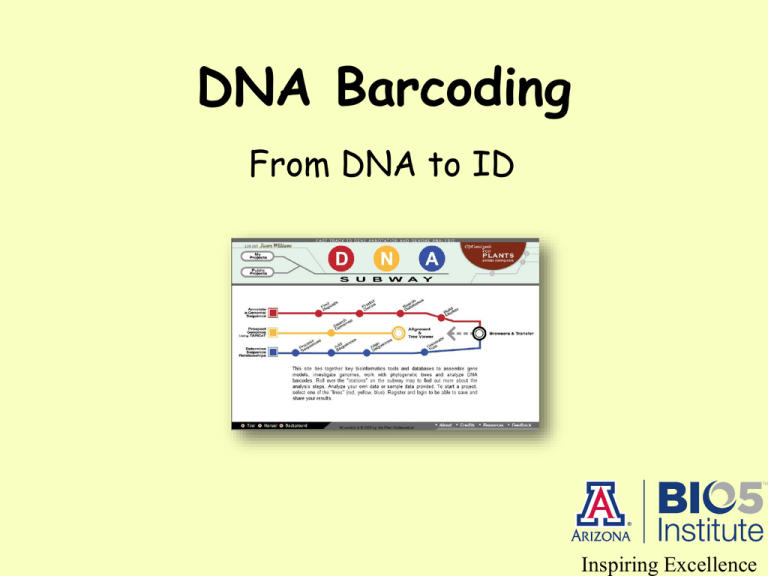
DNA Barcoding From DNA to ID Inspiring Excellence What is DNA Barcoding? ACGAGTCGGTAGCTGCCCTCTGACTGCA TCGAATTGCTCCCCTACTACGTGCTATA TGCGCTTACGATCGTACGAAGATTTAT AGAATGCTGCTAGCTGCTCCCTTATTCG ATAACTAGCTCGATTATAGCTACGATG ? = Inspiring Excellence What DNA Barcoding Works On CHLOROPLAST rbcL MITOCHONDRION matK CO1 Why DNA Barcoding Works Win: Sequence shows ~70% conservation, good for PCR, good as barcode Fail: Sequence is completely conserved, good for PCR, but uninformative as barcode Fail: Sequence shows no conservation, impossible for PCR, but good as barcode Why DNA Barcoding Works CHLOROPLAST rbcL MITOCHONDRION matK CO1 How DNA Barcoding Works 1. Sample Organism 2. Extract DNA 3. Amplify “Barcode” DNA ACGAGTCGGTAGCTGCCCTCTGACTGCA TCGAATTGCTCCCCTACTACGTGCTATA TGCGCTTACGATCGTACGAAGATTTAT AGAATGCTGCTAGCTGCTCCCTTATTCG ATAACTAGCTCGATTATAGCTACGATG 4. Sequence DNA 5. Compare sequence against database Why is DNA Barcoding Important? ACGAGTCGGTAGCTGCCCTCTGACTGCA TCGAATTGCTCCCCTACTACGTGCTATA TGCGCTTACGATCGTACGAAGATTTAT AGAATGCTGCTAGCTGCTCCCTTATTCG ATAACTAGCTCGATTATAGCTACGATG Inspiring Excellence Issue #1: No one knows how many species there are. How Many Species Can You Name? How many Animals did you name? How many mammals? How many plants? How many insects? “Dog” Canis lupus familiaris “Cat” Felis catus “Shark” Ginglymostoma cirratum “Oak Tree” Quercus alba “Beetle” Popillia japonica Vertebrates Species Mammals 5,490 Birds 9,998 Reptiles 9,084 Amphibians 6,433 Fishes 31,300 Total 62,305 Invertebrate s Species Plants Species Angiosperms 281,821 Insects 1,000,000 Gymnosperms 1,021 Mollusks 85,00 47,000 Ferns and Allies 12,000 Crustaceans Corals 2,175 Mosses 16,236 Arachnids 102,248 Algae 10,134 Total (+others) 1,305,250 Total 321,212 • Currently between 1.5 and 2 million species are described/known • This number may represent as little as half of the true number of species • Perhaps more than 1/3 of all species are threatened (IUCN Red list version 2010.1) Issue #2: There is a lack of agreement of what “species” means. Defining “species” is complex and depends on many factors: • Interbreeding capabilities Canis lupus Canis lupus (familiaris) • Morphological variation • Ecological context • Genetic similarities Anas platyrhynchos ? Issue #3: Traditional taxonomic identification methods may be inadequate and too slow to capture vanishing biodiversity Classical taxonomy is difficult for non-experts to understand Leaves alternate proximally, opposite and ultimately decussate distally, 6–16 × 4–13 cm; petiole ca. as long as blade, winged, base clasping, basal lobes stipulate, growing as extensions of wings, less than 1 mm wide; blade 5–7-veined, ovate, glabrous, base typically sagittate, margins entire, apex acute to acuminate. Staminate inflorescences axillary, 1–2 per axil, paniculate, fasciculate; panicles bearing flowers singly,bracteolate, in a zigzag pattern along rachis, internodes less than 2 mm; rachis to 25 cm, secondary axes 1–3(–6), fasciculate, less than 3 cm, each subtended by deltate-ovate bracteole shorter than 1 mm. Pistillate inflorescences solitary, 4– 8(–20)-flowered, 6–35 cm, internodes ca. 1 cm. Adding to the complexity: immature, damaged or incomplete specimen may make identification impossible. Issue #4: DNA Barcoding provides opportunities to investigate things DNA Barcoding Engages and Transforms Curiosity Into Practical Inquiry Kate Stoeckle August 23, 2008 What research questions could you ask? Research questions can be about any living thing or about non-living things (foods or other products) that have DNA. Examples: • Are there invasive (non-native) plants in my local park? • What are the most popular types of flowers in my city? • Do the teas I buy at my supermarket really contain the ingredients on the package? • How many different living organisms can I find in an office building? • Whose droppings are these? Inspiring Excellence Materials & Equipment for DNA Barcoding • DNA extraction Kit • PCR machine and reagents • DNA sequencing (Genewiz, other) • Bioinformatic tools (analysis of DNA sequence) Inspiring Excellence DNA Barcoding Analysis • Sequence • Prepare • Compare • Identify • Share Inspiring Excellence Contributing to big science BOLD GenBank Inspiring Excellence How DNA Barcoding Works 1. Sample Organism 2. Extract DNA 3. Amplify “Barcode” DNA ACGAGTCGGTAGCTGCCCTCTGACTGCA TCGAATTGCTCCCCTACTACGTGCTATA TGCGCTTACGATCGTACGAAGATTTAT AGAATGCTGCTAGCTGCTCCCTTATTCG ATAACTAGCTCGATTATAGCTACGATG 4. Sequence DNA 5. Compare sequence against database Assignments • Find NCBI’s MapViewer; identify difference between human and chimpanzee genome; check situation in all 4 other primate genomes provided • Make sea shell phylogenetic tree, work through hhmi.org/biointeractive/activities/shells/online/index.html • Review users.ugent.be/~avierstr/principles/phylogeny.html* • Review http://www.hiv.lanl.gov/content/sequence/TUTORIALS/TREE _TUTORIAL/Tree-tutorial.html* • Review Constructing an Evolutionary Tree (Binder) • Review Stockle paper on DNA, Taxonomy & Barcode of Life (pre-Readings) * Links worked on 2012 05 31; if they fail, find the 2 sites through Google Questions? Inspiring Excellence
